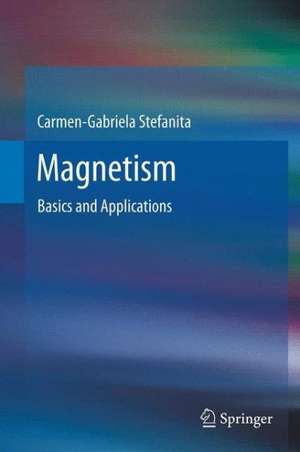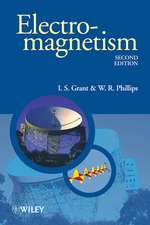Magnetism: Basics and Applications
Autor Carmen-Gabriela Stefanitaen Limba Engleză Paperback – 22 feb 2014
| Toate formatele și edițiile | Preț | Express |
|---|---|---|
| Paperback (1) | 391.61 lei 6-8 săpt. | |
| Springer Berlin, Heidelberg – 22 feb 2014 | 391.61 lei 6-8 săpt. | |
| Hardback (1) | 396.40 lei 6-8 săpt. | |
| Springer Berlin, Heidelberg – 13 ian 2012 | 396.40 lei 6-8 săpt. |
Preț: 391.61 lei
Nou
Puncte Express: 587
Preț estimativ în valută:
74.94€ • 78.44$ • 62.37£
74.94€ • 78.44$ • 62.37£
Carte tipărită la comandă
Livrare economică 31 martie-14 aprilie
Preluare comenzi: 021 569.72.76
Specificații
ISBN-13: 9783642430688
ISBN-10: 3642430686
Pagini: 360
Ilustrații: XXIV, 336 p.
Dimensiuni: 155 x 235 x 19 mm
Greutate: 0.5 kg
Ediția:2012
Editura: Springer Berlin, Heidelberg
Colecția Springer
Locul publicării:Berlin, Heidelberg, Germany
ISBN-10: 3642430686
Pagini: 360
Ilustrații: XXIV, 336 p.
Dimensiuni: 155 x 235 x 19 mm
Greutate: 0.5 kg
Ediția:2012
Editura: Springer Berlin, Heidelberg
Colecția Springer
Locul publicării:Berlin, Heidelberg, Germany
Public țintă
GraduateCuprins
Traditional Magnetism.- The Magnetization Process. Micromagnetism.- Magnetic Nondestructive Testing Techniques.- Uses of the Magneto-Optical Effect.- Magnetoelectric Materials.- Giant Magnetoresistance, Spin Valves.- Introduction to Spintronics.- Some Magnetic Recording Media Developments.- Concluding Remarks
Recenzii
Review by Dr. Rudolf Schaefer, Inst. Mat. Res. Dresden, Germany, author of the book Magnetic Domains:
It is surprising that – after so many general text books on magnetism – it is possible to come up with a new book which differs from the others. Carmen-Gabriela Stefanita has written an entertaining and in many aspects unconventional book. It touches basic aspects of magnetism as well as many modern aspects (like Spintronics) on an introductory level. Unconventional, nevertheless interesting, is the selection of topics and examples. It seems unlikely that lectures on magnetism can be prepared solely on basis of this book – too many basic aspects are missing to come up with a complete story. The book will nevertheless be a valuable reading for the preparation of lectures as many, especially modern topics on magnetism are presented in a descriptive way. Very useful are the many exercises in and at the end of each chapter. If available, I will certainly have this book on my deskand recommend it to students.
It is surprising that – after so many general text books on magnetism – it is possible to come up with a new book which differs from the others. Carmen-Gabriela Stefanita has written an entertaining and in many aspects unconventional book. It touches basic aspects of magnetism as well as many modern aspects (like Spintronics) on an introductory level. Unconventional, nevertheless interesting, is the selection of topics and examples. It seems unlikely that lectures on magnetism can be prepared solely on basis of this book – too many basic aspects are missing to come up with a complete story. The book will nevertheless be a valuable reading for the preparation of lectures as many, especially modern topics on magnetism are presented in a descriptive way. Very useful are the many exercises in and at the end of each chapter. If available, I will certainly have this book on my deskand recommend it to students.
Notă biografică
Dr. Stefanita is a physicist/materials scientist who received her Ph. D. degree in Physics (Magnetic Nondestructive Testing and Materials Characterization) from Queen’s University, Kingston, Ontario, Canada in 1999. Her Ph.D. thesis was "Surface Magnetic Barkhausen Noise Response To Plastic Yield of Steel". Previously, she received her Diploma of Engineer in Physics (Technological Physics) from the University of Bucharest, Romania in 1989 with the thesis "Apparatus for Measuring Solar Radiation Using a Thin Film Transducer". Dr. Stefanita also has a 1984 Baccalaureate in Mathematics and Physics from the German School of Bucharest in Romania.
Dr. Stefanita has over 15 years collective experience in academia and industry with international exposure on 3 continents, and 5 countries. Her research projects in nanotechnology have covered self-assembled metallic and semiconductor nanowires or nanodots, spintronics, magnetotransport, Hall effect, and infrared absorption and transmission. Her other work in magnetism involved magnetic behavior of plastically deformed steel, microyielding phenomena, cold rolling effects on magnetic properties, and magnetic nondestructive testing techniques for detecting defects in steel components. She has also developed a prototype for a medical diagnostics apparatus based on a thin film interference filter. Dr. Stefanita’s work in industry as a materials scientist covered areas of failure analysis, scanning electron microscopy, energy dispersive X- ray analysis, atomic emission spectroscopy and import of chemicals and raw materials. The university courses she taught include subjects in the fields of solid state devices, electromagnetics, and mechanics of deformables. Dr. Stefanita is a regular referee for nanotechnology papers, as well as a published author of a magnetics book, two book chapters, journal papers, conference publications, and internal reports.
Dr. Stefanita is a co-founder and Senior Partner with NanoDotTekbased in the Boston area, Massachusetts, USA. This company is dedicated to promoting nanotechnology, and allied areas such as non-destructive testing (the "NDT" in NanoDotTek) for engineering systems. With respect to the latter Dr. Stefanita is presently engaged in developing a lossy dielectric with a prescribed fractional impedance. This is in furtherance of improving fractional order control systems and pulse shaping for wireless broadband communications. Dr. Stefanita is a licensed Professional Engineer in the Province of Alberta, Canada.
Dr. Min Namkung recieved his Ph.D in physics from the College of William and Mary in 1982 with his dissertation on the subject of magetic hyperfine field probed by the muon spin rotation method which demonstrated the uniaxial stress-induced magnetic domain alignment in bulk iron samples. In the same year he joined NASA Langley Research Center. For the following years, he estblished the magnetoelastic and magnetiacoustic nondestructive evaluation methods for the characterization of residual stress and temper embrittlment, respectively, in structural ferromagnets. Following the Aloha Ariline incident in 198, in which a Boeing 737 passenger aircraft lost a large portion of fuselage while cruising , Dr. Namkung was assiged to develop an electromagntic for the detection of cracks in aircraft bodies. Dr. Namkung and his team at NASA Langley Research Center developed a self-nulling eddy current technology that was capable of detecting fatigue cracks hidden under rivet headsthat holds the lap joints of aircraft. Dr. Namkung has been awarded with 14 US Patents on the subjects of mangetic and electromagnetic NDE methods, and he has published more than 100 papers in journals and conference proceedings. Since 2005, Dr. Namkung has been a member of NASA Goddard Space Flight Center with his main research focus on computational materials science, and UV-VIS and gamma-ray spectroscopy.
Dr. Stefanita has over 15 years collective experience in academia and industry with international exposure on 3 continents, and 5 countries. Her research projects in nanotechnology have covered self-assembled metallic and semiconductor nanowires or nanodots, spintronics, magnetotransport, Hall effect, and infrared absorption and transmission. Her other work in magnetism involved magnetic behavior of plastically deformed steel, microyielding phenomena, cold rolling effects on magnetic properties, and magnetic nondestructive testing techniques for detecting defects in steel components. She has also developed a prototype for a medical diagnostics apparatus based on a thin film interference filter. Dr. Stefanita’s work in industry as a materials scientist covered areas of failure analysis, scanning electron microscopy, energy dispersive X- ray analysis, atomic emission spectroscopy and import of chemicals and raw materials. The university courses she taught include subjects in the fields of solid state devices, electromagnetics, and mechanics of deformables. Dr. Stefanita is a regular referee for nanotechnology papers, as well as a published author of a magnetics book, two book chapters, journal papers, conference publications, and internal reports.
Dr. Stefanita is a co-founder and Senior Partner with NanoDotTekbased in the Boston area, Massachusetts, USA. This company is dedicated to promoting nanotechnology, and allied areas such as non-destructive testing (the "NDT" in NanoDotTek) for engineering systems. With respect to the latter Dr. Stefanita is presently engaged in developing a lossy dielectric with a prescribed fractional impedance. This is in furtherance of improving fractional order control systems and pulse shaping for wireless broadband communications. Dr. Stefanita is a licensed Professional Engineer in the Province of Alberta, Canada.
Dr. Min Namkung recieved his Ph.D in physics from the College of William and Mary in 1982 with his dissertation on the subject of magetic hyperfine field probed by the muon spin rotation method which demonstrated the uniaxial stress-induced magnetic domain alignment in bulk iron samples. In the same year he joined NASA Langley Research Center. For the following years, he estblished the magnetoelastic and magnetiacoustic nondestructive evaluation methods for the characterization of residual stress and temper embrittlment, respectively, in structural ferromagnets. Following the Aloha Ariline incident in 198, in which a Boeing 737 passenger aircraft lost a large portion of fuselage while cruising , Dr. Namkung was assiged to develop an electromagntic for the detection of cracks in aircraft bodies. Dr. Namkung and his team at NASA Langley Research Center developed a self-nulling eddy current technology that was capable of detecting fatigue cracks hidden under rivet headsthat holds the lap joints of aircraft. Dr. Namkung has been awarded with 14 US Patents on the subjects of mangetic and electromagnetic NDE methods, and he has published more than 100 papers in journals and conference proceedings. Since 2005, Dr. Namkung has been a member of NASA Goddard Space Flight Center with his main research focus on computational materials science, and UV-VIS and gamma-ray spectroscopy.
Textul de pe ultima copertă
This textbook is aimed at engineering students who are likely to come across magnetics applications in their professional practice. Whether designing lithography equipment containing ferromagnetic brushes, or detecting defects in aeronautics, some basic knowledge of 21st century magnetism is needed. From the magnetic tape on the pocket credit card to the read head in a personal computer, people run into magnetism in many products. Furthermore, in a variety of disciplines tools of the trade exploit magnetic principles, and many interdisciplinary laboratory research areas cross paths with magnetic phenomena that may seem mysterious to the untrained mind. Therefore, this course offers a broad coverage of magnetism topics encountered more often in this millenium, revealing key concepts on which many practical applications rest. Some traditional subjects in magnetism are discussed in the first half of the book, followed by areas likely to spark the curiosity of those moreinterested in today’s technological achievements. Although sometimes some aspects may seem difficult to comprehend at first, bibliography directs the reader to appropriate further study. Throughout the chapters, the student is encouraged to discover the not-so-obvious associations between different magnetics topics, a task that will prove to be at the very least rewarding.
Caracteristici
Complete and up-to-date textbook on magnetism for students of engineering and physics Includes all the latest developments like nanomagnetism, giant and colossal magnetoresistance, spintronics Also deals strongly with applications to magnetic storaging Uniquely integrates physics, materials sciences and technological basics Provides exercises and solutions as learning and teaching material Includes supplementary material: sn.pub/extras












